Ever since I started diving into studio photography the term “V-Flat” has been a big mystery to me. Google and YouTube have been the quintessential resource for photography knowledge and for whatever reason there isn't much detailed information on how to construct a V-Flat or what purpose they actually serve. It took time to sift through the noise of nonsensical DIY fabrication and even more time to unfold the enigma of this studio essential.
In preparation for this article, I asked around the photo community and many photographers knew of the term “V-Flat” but most had no idea what purpose they served or how they were made. Apparently, there is a grand perception that V-Flats are an elusive tool that only big studios and professional photographers can access, as you can’t buy them as your local camera store.
The term “Flat” comes from the world of Italian renaissance theater. Flats are large rectangles of lightweight foamcore which are used to create background scenery such as buildings or walls. They are easily movable and can create a sense of location and place with little time. In the photography world, it's common practice to hinge two of the Flats together, in turn creating a letter “V,” hence the name “V-Flats.”
For me, it all started from seeing these huge Flats in play. I had witnessed Sue Bryce create magical natural-light portraits with her versatile V-Flats and my friend Josh Eskridge incorporate his DIY foam Flats in a series of incredibly unique light setups. I had to step up and make it happen.
Tools
Construction is quite easy, but the most important thing is making sure you have ample room to do it. I have a very small living room studio, so it took some cleaning and "Tetris" to put the flats together. If you need to go outside, then go outside. Remember, you’re dealing with 8 foot pieces of foam board that should be handled with care.
- 4 Sheets - ½” 48” x 96” Black/White Reversible Gatorfoam
- Blade or Sharp Knife
- 4” Wide Black Gaff Tape
- 3” Wide White Gaff Tape
- 2 Clamps
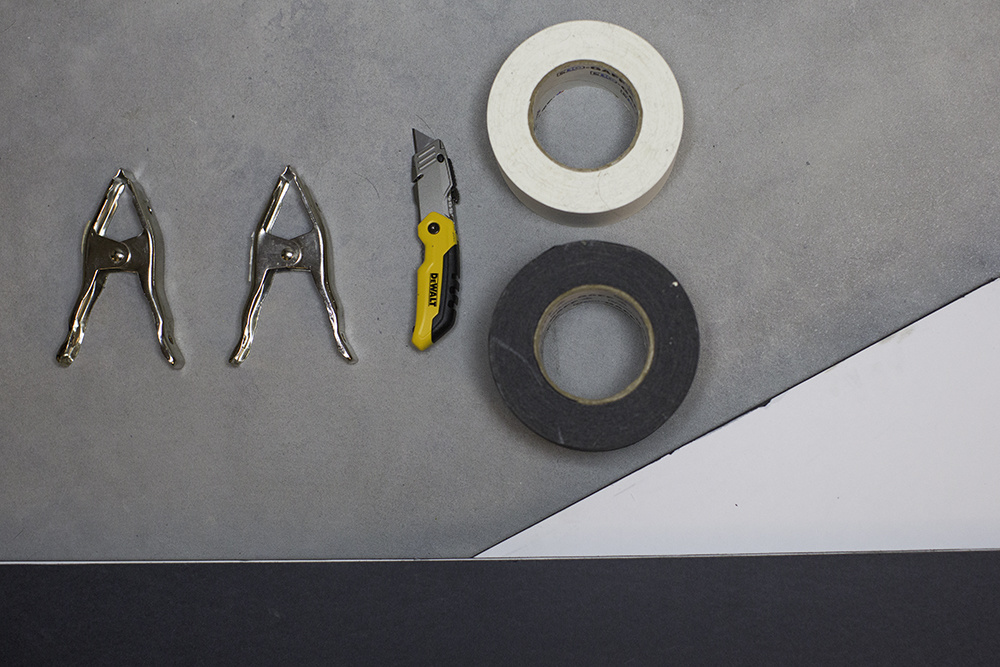
Flats
After a day or two of phone calls and an deep exploration of the internet, I found the answer to what is the biggest conundrum of this whole construction; where to purchase the Flats. As photographers, it’s important for us to network and know people. If you purchase prints of any kind in your local market and happen to know someone who is employed at that lab, that person will probably know someone at a sign company or plastics distributor. Ask around or make some cold calls, you're bound to find some information. Just pick up the phone or draft an email to a local sign company.
Foamcore is lightweight and can be easily cut, but apparently it can breakdown and puncture with ease, therefore on the advice of my contact, I found Gatorfoam Board. Gatorfoam is high-quality polystyrene bonded between two layers of wood-fiber veneer and it’s dent/scratch resistant. Gatorfoam can come in various sizes, thickness, type, brand and color, so it’s important to know what you need before you call. In this case we need a solid thickness for strength and a Flat that is reversible, matte black on one side and matte white on the other. Pricing can vary, but I’ve found Gatorfoam can get expensive quick and may break upwards of $75 a sheet, depending on your local contact. This is what I use and what I recommend: ½” 48” x 96” Black/White Reversible Gatorfoam.
And, remember you will definitely need a big truck for transport.
Construction
Once you have the necessary tools, let’s start from square one.
- Stack two of the flats side-by-side(with one board slightly higher than the other to reduce fold tension) both on the black side and clamp off both ends so they remain in place.
- Run the Black gaff tape along the center of the length of both boards.
- Fold the tape over and seal to each side. Cut off any extra tape with the blade.
- Remove the clamps and flip the boards over to the white side.
- Run the white gaff tape along the center of the length of both boards.
- Fold the tape over and seal to each side. Cut any extra tape with the blade.
- Stand the V-Flat up.
- Repeat this process with the other two flats.

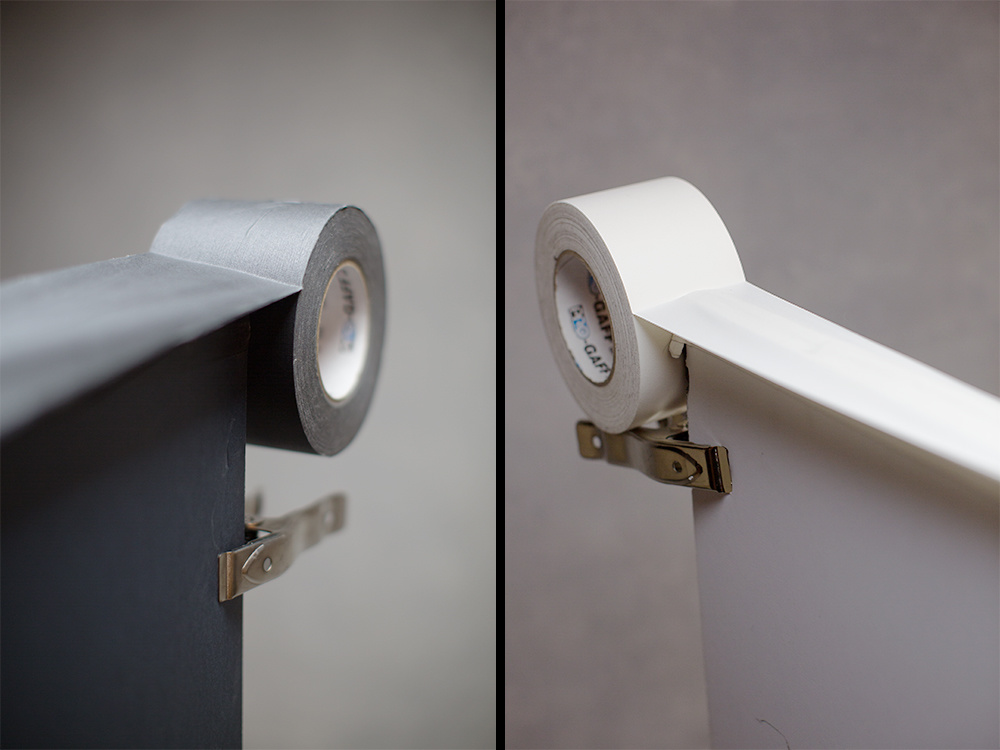
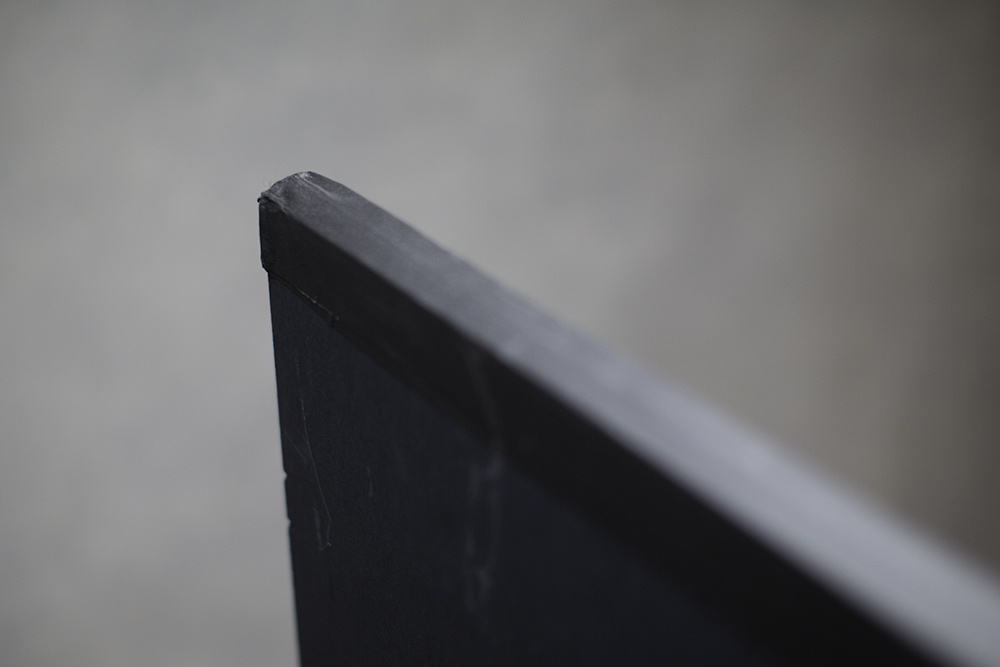
At this point, you may notice some tension when attempting to fold the two flats together. But, the beauty of gaff tape is that it can stretch. Slowly push the two flats together and the gaff tape should with stretch with the fold. The Gatorfoam will take the tension and not break under the pressure.
Just like that, you’ve got some high-quality studio V-Flats.

Why?
V-Flats are not only great for bouncing light and cutting light, but they are also great for building a set or using as a background. The matte white bounces light and is non-reflective, so it can be used as a solid seamless background resembling Savage paper. The black matte is great for cutting light and flagging light. I also use the black side of the V-Flats for background for not only my photos, but also for any live webcasts and podcasts.
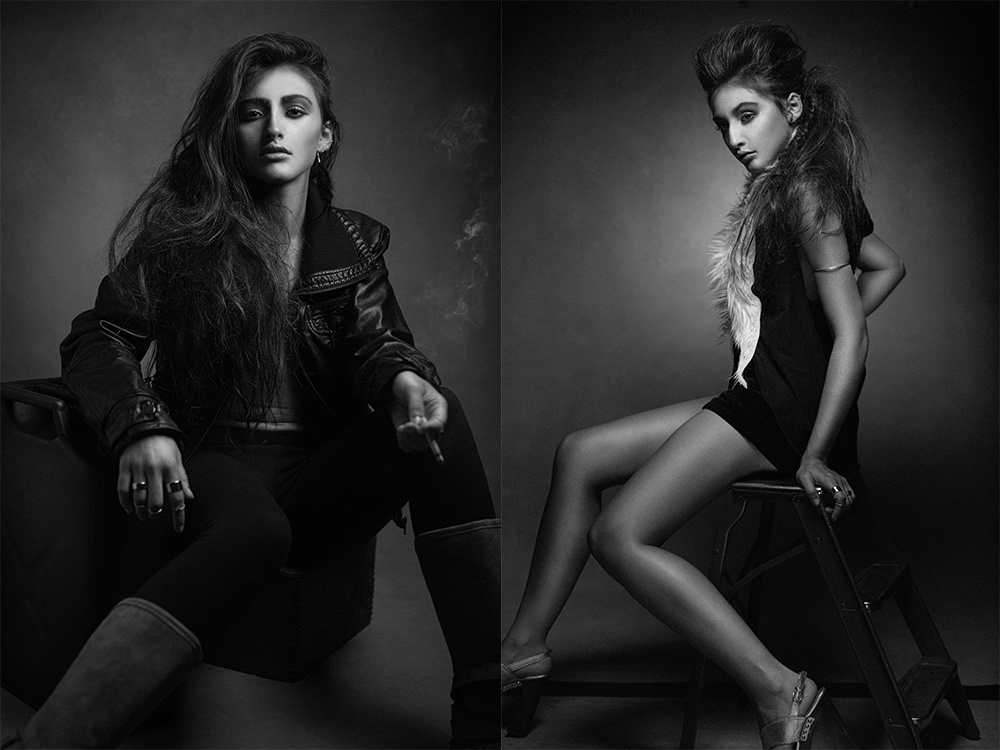
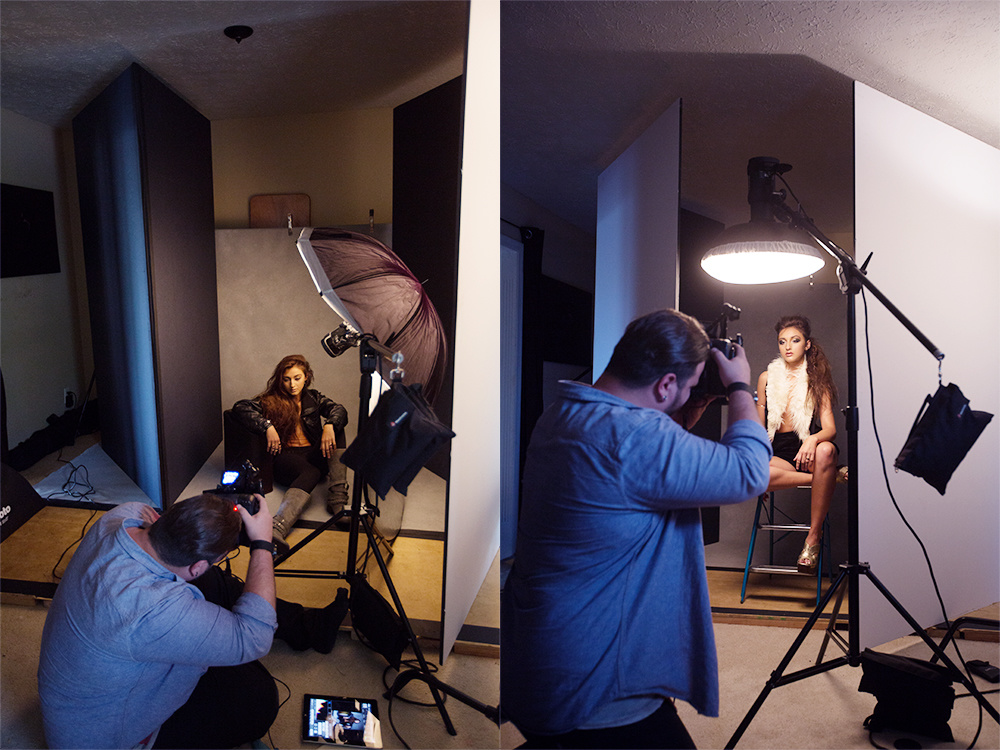
The versatility of V-Flats are endless and I feel as I have only scratched the surface of their use. I’m constantly finding new and inventive ways to use them, such as using them as flooring or creating background or even using them simply to create set separation, which gives the subject a private space. I’ve even found that they look good when they are included in the shot, which can create depth and dimension to the background.

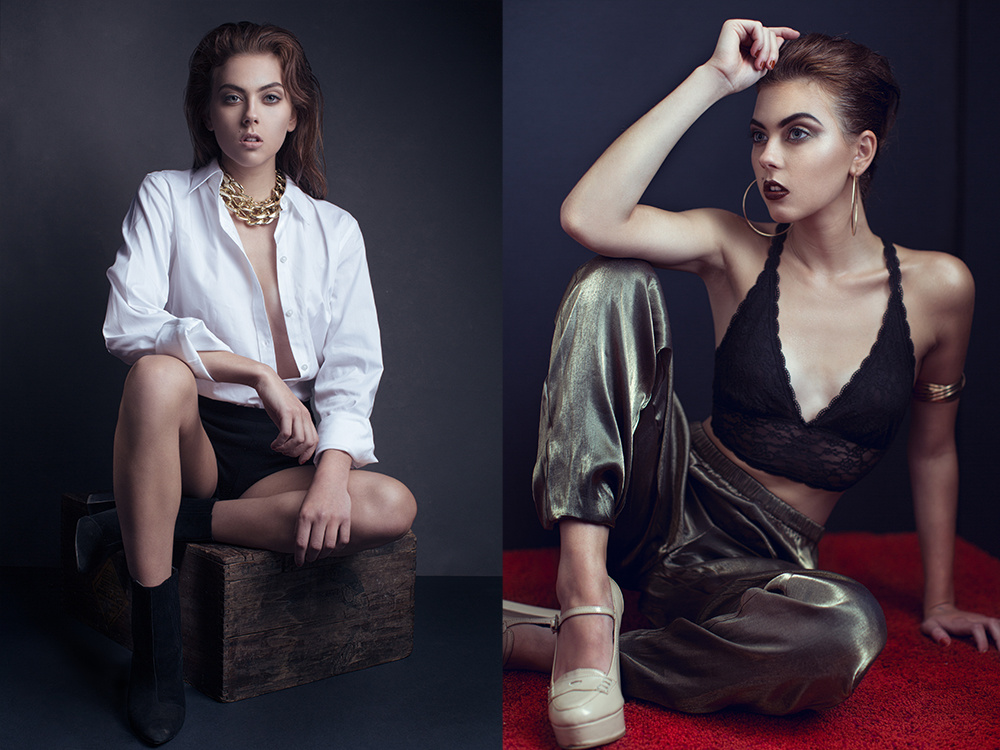
If you’re like me and shoot in a living room studio space, V-Flats can be a crucial tool to creating those beautiful portraits that we constantly long for. Make some calls, make the investment and I guarantee you won’t regret it.
If you'd like to learn more lighting and shooting tips, consider checking out our Fundamentals of Fashion Photography course with Shavonne Wong or our more in depth Fashion and Editorial Portrait Photography tutorial with Clay Cook. If you purchase it now, or any of our other tutorials, you can save a 15% by using "ARTICLE" at checkout.







Good write up. I recently purchased a set of v-flats for a Fremont studio in Norcal. There's a theatrical supply shop called Musson in Santa Clara for all those that live in the Bay Area. I didn't get the Gator Board, too pricey. The sell the 3/16" sheets, black on one side and white on the other for $18.00 a sheet :) They are awesome! Here's a gallery that shows them in use. I had an entire cyc wall to work with but for alot of the shots I just shot in front of the v-flats http://paulferradasphotography.pixieset.com/camilleelizabeth/
Thanks for reading Paul! Very awesome!
Paul....nice gallery
very nice Gallery! Off to Lowes I go.
I constantly shoot on location and foam v-flats never last very long. However, my current v-flats are made from cheap hollow doors (found at any home depot) with double jointed hinges. You have to cover them in some sort of fabric to seal up the crack (I used a painter's tarp), and then you paint them. They are heavier (though my small assistant— sorry Lindsey— can still easily move them), but infinitely more durable. They've been through hell, but are still going 7 years on.
Right on, thanks for reading. Cool insight! Those sound like some durable V-Flats!
JJ post a picture of those. I' would love to see what they look like :) Also...... another great article Clay!
I'm out of the studio for the next couple of weeks, but I'll describe it for you. The doors are white, so after I hinged the two together, I fold them shut (like in this article). I then covered the outside of folded doors with a painters tarp, wrapping it all the way from one side to the other across the hinges. I think I ended up using contact cement to make it stick— the doors have a plastic laminate on them and it took a while to get something to adhere. I then trimmed the edges and painted it black with household paint. The other sides were already white, so I left them.
The one main difference between these and the foam Vs, other than weight, is that the doors I used were each only 30in wide. Which means that you can use them for a backdrop on smaller items, but not people.
BTW, I also left the door knob hole open on them. It makes it easy to loop a strap through them to keep them closed and to use as a handle to carry them.
Thanks Matthew! Appreciate you reading!
Great article Clay!! It's nice to see a detailed write up along with videos for demonstration. Thanks
Thanks Lucas! Really appreciate that!
Hold my beer. I can do this.
Yes! You can do it!
V-Flats are great for the studio, if you really want to see the negative effect that they have use a ring flash with black flats on both sides and a black piece of foamcore lying across the top the ring shadow is amazing. If you are working in small spaces I prefer to use a fabric version that is easy to make, I use black and white duvatyne or commando cloth 4' x 8' sewn back to back then I sew a pocket at the top to put in a 4' x one inch thick dowl. use a light stand with a superclamp on top of it and clamp in the middle of the dowl and you have your black or white side. when you are done just roll it up on the dowl and throw into your tripod bag
Awesome! Thanks for sharing!
Good write up, and good technique for build. I always appreciate a well constructed set of v-flats. Here's a few other things worth mentioning...
I'm not sure why you spec'd two different widths of gaff tape, I'm sure that running 4" on both sides would be fine as well. I've always made them with 2" gaff, but I run three pieces on each side... one down the middle at the seam, and then one on the flat part of each board to give more strength (effectively creating a 5" wide piece of gaff). I imagine that 2" gaff is slightly more common to have lying around, so don't feel like you have to go buy special tape for this.
I would also highly recommend running another single piece of black 2" tape around every edge. As V-flats age, the edges are what tend to go first (from bumping into ceilings, walls, corners, etc). This extra protection will significantly prolong their life.
Finally, I can't stress enough how much better flats built from 1/2" or 3/8" board are over flats build from thinner foam core. They last WAY longer, primarily because they are much less prone to warping and bending. As long as you are taking the time to put these things together, it is very worth going out of your way to get the thicker stuff.
Thanks Brandon! From research, 3" white gaff tape was the widest I could find. Great recommendations here folks. Thanks again!
Always great info,
Thanks Clay
Thanks for reading Steve! Appreciate that.
Aluminum light panels can a good alternative. I have a Calumet one that's 42" by 78" with black, silver, white, and transparent fabrics. I wish it was taller, but it breaks down very easily into a small, lightweight package. I might buy a second one with clamps so it can fold like a v-flat.
Right on Michael! Thanks for the alternative tips!
I use foam-cor, but that's probably because the Set Shop in NYC is in my building. If you travel with the boards, you can tape around the entire edge, they'll hold up better.
Run the white side first along the edge and cover the outside edge, then the black side along the edge and double up on the outside end. No need to comment on my post.
For the shots where you don't use the v-flats for a background, I don't understand why you need black v-flats unless the wall of your studio is right there reflecting light. Some with and without photos would be greatly helpful in showing the effects of a black v-flat.
I can't speak for the author, but I use them as flags to keep spill from the background off the subject. You'd be surprised how much light is being reflected or wrapped around the subject.
Thanks James!
Firstly, thanks for reading! The black side of the V-Flat is to flag and cut light where I need it. Sorry I wasn't clearer on that!
Thank you for responding. Yes, I understood the concept. I'm just saying before and after photos would get your message across better. Without sample photos, I have to go through this whole build process to actually see the impact? That's a tough sell...
Very useful tutorial. Practical and easy to follow. Nice work!
Thanks Phil! Really appreciate that!
fantastic..would like to have this in my studio
Thanks for reading Gabriel! You won't regret it! :)
great write up
Thanks Chris! Appreciate you reading!
The first modifier I had following a strobe and an umbrella was a v flat. Love them. One of my favorite uses is cutting a hole for your lens and bouncing light into the white side for an amazingly soft, on axis fill. I'm always amazed at how endless the uses for foam core are!
Totally Derek! Thanks for checking it out!
Great post! What was your lighting set up? Do you have a post for it or can you write one? Please!!! The lighting was amazing! What were you using? Thanks!!
Thanks Robert! I've written a few articles on lighting, check them out here: https://fstoppers.com/profile/828/articles
That textured background looks great. May I ask where did you get that?
Thank you Karen! Oliphant Studio, NYC.
Thanks for reading! I'm sorry I didn't answer the "Why? question enough. Bouncing light, cutting light, background, studio privacy. That is enough for me. And in my opinion, throwing light at a white wall would be great if I was trying to fill the space with light, but I'm not. My intention is to create an dramatic portrait.
Great article.
Would you say there is an advantage, or, maybe a specific time to use V-flats instead of seamless or in front of a cyc wall?
Thanks for checking it out Josh! Sure, V-Flats tend to look like natural walls with a 90 degree angle. Seamless paper and Cyc walls have the bend which creates the seamless look. It's all up to you and what your trying to create!
Awesome DIY, sorry if I missed it, did not see a cost of supply list, what was the total cost for the supply list? I may be up to building this really soon! TIA..
Thanks for reading Miguel, I believe the total cost for me was around $300, the Flats are obviously the most expensive item here. Remember, I went with quality over cost effective.
I appreciate the article, and the higher end v-flats. But as you know most of us don't make much from photography or would prefer investing in other areas like lenses. Would you recommend which alternative option for those on a smaller budget? I've looked the the cost of a 6" Length x 48" Width x 1/2" Thick, White/Black gatorboard and it was $103... EACH! I could buy a brand new 85 1.8 canon lens with that lol...
Thanks for reading Chris! Quality doesn't come cheap, that's for sure. I'm always up for purchasing cost effective gear, but from experience it's really bit me in the ass and I've ended up buying gear twice. You can save your money by getting a less expensive Flat. You can go with Foamcore, but be warned, it won't last!
Love this article and is one of my favorite types. Take one simple (seemingly insignificant) lighting utility or technique and *really* break it down and understand it. A very good read and as for the black V flats I suspect many of us would be surprised how much spill we are actually getting without them.
Thank you Jason! That means a lot, really glad you enjoyed it my friend!
Great Article, Thanks for sharing!
Thanks for another great article Clay. I checked a local sign shop and they are charging $200 for one. I have to check a few other places.